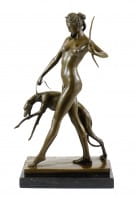Discover the Pantheon – Statues of Greek Gods and Goddesses
From Mount Olympus to modern homes, the legacy of the gods lives on. Our collection includes a wide range of Greek god sculptures representing the major and lesser-known deities of Greek mythology:
- Zeus – King of the gods, ruler of the sky, and symbol of power, justice, and authority.
- Poseidon – Lord of the seas, horses, and earthquakes, ideal for those who resonate with nature’s primal forces.
- Apollo – God of the sun, music, and prophecy, representing light, harmony, and intellectual pursuits.
- Hermes – Messenger of the gods, protector of travelers, and bringer of communication and commerce.
- Ares – The embodiment of war, strength, and raw energy — for spaces that celebrate courage and action.
And of course, the eternal beauty and grace of the Greek goddess statues:
- Aphrodite – Goddess of love and desire, associated with beauty, sensuality, and creation.
- Athena – Goddess of wisdom, warfare, and strategy — an iconic figure of intelligence and protection.
- Artemis – Huntress and protector of nature, symbolizing independence and purity.
- Hera – Queen of Olympus and goddess of family and marriage.
Each Greek god statue carries a deep symbolic resonance, ideal for creating an environment charged with meaning, elegance, and history.
Roman Statues – Classical Aesthetics Reimagined
Many of our sculptures also reflect the refined influence of Roman art. The Roman statues in our collection often depict the same gods and goddesses but in slightly different styles — emphasizing realism, grace, and imperial elegance. Roman versions of Greek deities can be identified by their attire, posture, and expressive details, making them especially popular among art historians and collectors.
These pieces are perfect for creating a neoclassical atmosphere in gardens, offices, courtyards, libraries, and other curated spaces.
Premium Craftsmanship and Timeless Materials
Our Greek god sculptures are available in a variety of materials to suit any aesthetic and space:
- Resin-marble blends for lightweight yet detailed indoor displays.
- Bronze and bronze-finished resin for durability and rich classical patina.
- Stone and concrete for enduring outdoor presence, perfect for garden sanctuaries or temple-inspired landscaping.
- Plaster and alabaster finishes for museum-quality detail and traditional interior settings.
Each piece is hand-finished or artistically cast using classical techniques, ensuring that every detail — from flowing robes to expressive gazes — reflects the majesty and legacy of ancient statuary.
For Every Space – From House Decor to Outdoor Sanctuaries
Our Greek goddess statues, statues of Greek gods, and Roman statues can be used in countless ways:
- Interior house decor – Place a statue of Athena in your study for wisdom and inspiration, or Aphrodite in the bedroom for love and beauty.
- Spiritual or altar spaces – Use Apollo, Hecate, or Hermes for energy work, prayer, or myth-based spiritual practice.
- Garden displays – Turn your outdoor area into a classical retreat with marble-look Greek god statues beside fountains, columns, or pathways.
- Hotels, wellness spaces, or yoga studios – Bring elegance, calm, and ancient symbolism into commercial environments.
- Museums, schools, and institutions – For educational displays or cultural exhibitions inspired by ancient Greece and Rome.
Whether you're designing a sacred space, a neoclassical garden, or a personal temple of self-expression, these sculptures help you connect with mythology, history, and artistry in a tangible, visually striking way.
Why Choose Our Greek God Sculptures?
- ✅ Authentic designs inspired by ancient originals from Greece and Rome.
- ✅ Hand-finished details for realistic texture and expression.
- ✅ Durable materials suited for indoor and outdoor use.
- ✅ Available in various sizes – from shelf-sized statues to life-size garden sculptures.
- ✅ Worldwide shipping and secure packaging for safe delivery.
Browse Our Greek and Roman Statues Collection Today
Immerse yourself in the power, mystery, and beauty of ancient mythology. Our collection of Greek god statues, Greek goddess statues, Greek god sculptures, and Roman statues invites you to create meaningful spaces where art and myth live on.
Explore our range today and find the divine figures that resonate with your vision, your space, and your soul.





























